



Once during the 1820’s, Parramatta Observatory produced many important discoveries and observations of the then poorly unexplored southern skies. At its short zenith, this observatory and its works held the popular imagination throughout Australia and much of scientific community in Europe. Yet for its many shortcomings, all that remains on the observatory site is the old weather-beaten “Transit Piers” and the solitary obelisk, placed in an undistinguished spot of the popular recreational area called Parramatta Park.
Sadly, the long-held reputation among astronomers and historians concerning Parramatta Observatory is commonly perceived as an example of a spectacular failure, whose works promised so much and whose later publication in 1835 proved almost unusable. In some ways these negative or mixed views are justified, as the main goal of producing an accurate positional southern sky star catalogue was never achieved.
Several articles have appeared over the years, and several are also available on the Internet. Some are certainly more complete in both factual detail and research, but few do discuss the implications and particular difficulties of the observational program made in New South Wales during the early 19th Century. My historical version here is just the slow continuing progression, which I have been adding as new information as it comes to hand. You may ask; So why should I want to write about this old observatory?
My interest in Parramatta Observatory started at an early age, which was main piqueted by visits to Sydney Observatory in the late 1960’s. At this then fully functioning establishment, much of the old astronomical equipment used at Parramatta Observatory was on general display throughout the Observatory. Although most was in delapidated state, it left the sense of real history, and made me want to investigate it further. My other new interest during this time was regarding the southern double stars, which were also first undertaken in the 1820’s by both James Dunlop (1793-1848) and Charles Rümker (1788-1862). Much of the inspiration was from the two-volume classic 19th Century book “Celestial Objects for Common Telescopes.” In fact, this was one of the first observational books I owed, being the general updated Dover Edition published in 1961. Although this book is almost entirely written for the northern hemisphere, the useful appendicies covered the remaining southern skies. Much of the detail is given in non-descriptive tables covering double stars, stars with remarkable spectra, variable stars and deep-sky objects. The selection was written in South Africa by R.T.A Innes during the mid-1920’, and contained many of the interesting southern telescopic objects - most being found by either James Dunlop or Charles Rümker. My earliest observations were of these stars, being easily seen in small apertures, and so become the affinity for early Australian astronomical history.
Years later, these experiences has found me again very interested in the whole history of Parramatta Observatory and the observations made there.
In time all these pages will be expanded, but in the meantime, I hope you find this article either useful or at least informative.Andrew James: 29th April 2006.
For other Astronomical Historical Information see;
INDEX : SOUTHERN ASTRONOMY and AUSTRALIAN HISTORY
After the establishment of the initial Dawes Observatory, some thirty-three years were to pass before astronomical observations and a new observatory was established. This new Observatory immediately began when the nominated Governer for New South Wales, Sir Thomas Macdougall Brisbane (1773–1860) arrived in Sydney in November 1821 together with his two hired astronomical assistants Charles Rümker (1788-1862) and James Dunlop (1793-1848).
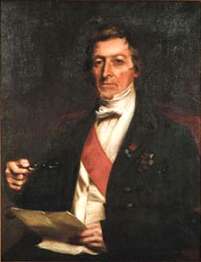
Thomas Makdougall Brisbane was born on the 23rd July 1773 in Ayrshire, Scotland. He was educated at the University of Edinburgh and attended the English Academy at Kensington. His military career was both long and distinguished, rising through the ranks to become Brigadier-General in 1812. He also fought in the Battle of Waterloo in 1815. Applying for the Governorship of New South Wales in 1815, upon the recommendation of the Duke of Wellington in 1812. Thomas Brisbane also announced his own personal desire to establish the first free-standing observatory in Australia. A Scottish philanthropist, Brisbane was already a very keen amateur astronomer and had established his own observatory in 1808 at Ayrshire. From here he gained some academic reputation both both the Royal Society and the London Astronomical Society. The Observatory was likely one of his main motivations for the job, as the southern skies had not been suitably explored.
After six long years of waiting, Brisbane became the Sixth Governor of New South Wales, which he held between 1821 and 1825, replacing the renown Governor Macquarie. During this time, he revised the local currency, organised new expeditions into the Blue Mountains, 80km. west of Sydney, and established land grants and titles for the fast expanding Colony. He alsocontinued Macquarie’s aims of improving agriculture in the region. In Australia, his name is remembered for the place known as Brisbane Waters, which are shallow waterways around Gosford, Ettalong and Woy Woy some 50 kilometres north of Sydney. Also the Queensland capital city of Brisbane and the Brisbane River were named for him. (As in 1983, when the local Sir Thomas Brisbane Planetarium.) These latter names where nominated by Lt. John Oxley, was was sent in 1823 to find a new penal colony for the many troublesome or truely criminal convicts. Lt. Oxley soon discovered the river flowing into Moreton Bay, some 1000 kilometres north of Sydney in now suthern Queensland, which at that time was also part of New South Wales. By 1824 a new northern colony was established. After his Governorship in New South Wales had lapsed, Brisbane briefly visited the site in 1826 before returning to Scotland. He was to achieved the high rank of General in 1841. The highest position in academia was as the President of the Royal Society in Edinburgh in 1832. Brisbane died at the age of 86 on the 27th January, 1860 at Largs.
In actuality, the initial Parramatta Observatory was Sir Thomas Brisbane’s own private property financed completely out of his own pocket. He also employed two astronomers, as paid for the observatory structure, instruments, clocks and its library. The Observatory itself was selected to be located in now Parramatta Park, mainly for its close proximity to the old Colonial Government House. Here the skies were both clear and dark, with the first observation occurring in the open air during the summer solstice on the 22nd December 1821. Within four months, the established observatory was setup with its main 92mm. (3.75-inch) Edward Troughton transit telescope (made in 1820), the 2-foot mural circle and the 80mm (3.25-inch) equatorially mounted telescope. (See Figure 1)
Two pendulum clocks were also provided. The first clock (Fig.2 Left) was made by the French clockmaker of some reknown, Breguet. The clock (Fig 2. right was the sidereal clock. Both are now housed in Sydney Observatory. Although still functioning, they are fairly inaccurate. All the observers during the time of Parramatta Observatory had to always calibrate the local time and the local sidereal time through astronomical observations.
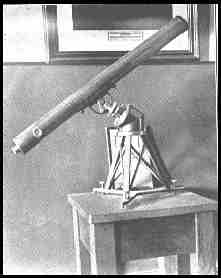
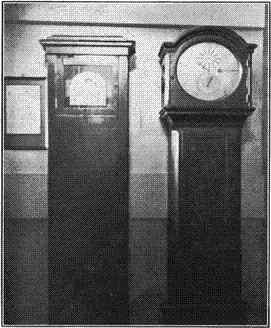
|
The building’s simply structure was made of wood and canvas, with two metre sandstone piers - completed in March 1822. One of the only known plans of the Observatory exists in the main star catalogue, and was drawn by the Rev. W.B. Clarke in 1825.
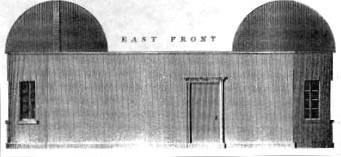 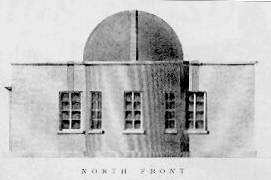 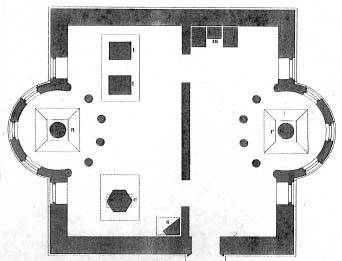
|
Quickly, Parramatta Observatory established an extensive astronomical observing program. The primary undertaking was the catalogue of star positions of the southern skies using the mural circle, meridian telescope, and transit telescope. Within four years (1825) the places of 7385 stars had been determined - the basis of which became known as the abbreviated name of the “Paramatta Catalogue of 7385 Stars”. This major work, produced at Parramatta Observatory, was the second substantial star catalogue of the southern skies, following the adequate South African Lacaillé Catalogue of 1752-53. In March 1822 started the arduous task, ending with the initial reduced manuscript completed by March 1826. For these efforts Brisbane was rewarded by the Royal Astronomical Society in 1828 with their prodigious Gold Medal. Later, the catalogue was further reduced by William Richardson of the Greenwich Observatory in 1830, to be finally published in 1835.
Dunlop and Rümker did the bulk of the observations for the catalogue, but also discovered new celestial objects unbeknown at that time. James Dunlop was born on 31st October 1793 at Dalry (near Glasgow) in Scotland. Christian Carl Ludwig Charles Rümker was born on the 18th May, 1788 in Stargard, Mecklenburg, Germany.
Dunlop was to see out the whole star catalogue project, but in June 1823 Rümker, after a dispute with both Brisbane and Dunlop and left Brisbane’s employment to farm at Reservoir Hill, Picton, NSW. (The main reason seems to be that Rümker had better qualifications than Dunlop, and this caused a degree of friction between them, especially in the credit for the observations. This lead to irreconcilable differences.) During this time Rümker’s reputation was as the first person to rediscover the periodic Encke’s Comet on its first return in 1822. Away from Parramatta, he discovered in 1824 the first bright comet of his own.
Between May 1826 until October 1829 Rümker was to return to Parramatta, under some duress, as the Government Astronomer. This was mainly due to Brisbane ending his Governorship and returning to Scotland in late 1824. He remained as governor until he relinquished it on the 1st December 1825 to Governor Ralph Darling. The observatory was sold by Brisbane in the same month, to the NSW government for £1 614 13 shillings. Final payment remained in dispute for several more years.
Here Rümker pursed new observations of comets, transits observations and double stars. Of the double stars he found twenty-six in total, of which only twenty are recognised today.) Pairs are now designated Rmk or RMK. Most of these pairs were discovered in the survey of bright stars for the transit programme. For the amateur astronomer, most of the pairs he discovered are rather attractive and easily seen in small or moderate telescope.
Rümker was eventually rewarded with a Gold Medal by the Royal Astronomical Society in 1854. In retrospect, Rümker’s observations proved far more significant than the works of Dunlop, and he went on to do bigger and better things, including becoming a prominent and celbrated figure in Germany. Furthermore he had the education and abilities of an astronomer where Dunlop was essentually and amateur who did his best under the circumstances. Regardless, due to these high and favoured accolades, Rümker suffered some personal hostility from both Brisbane and Dunlop, even after his return to Europe in November 1830. He played no further role in southern observations. Later he became a lecturer on Navigation between 1831 and 1857, and then the director of the Hamburg Observatory in Germany between 1833 and 1857. Charles Rümker died in Lisbon, Portugal in the 21st December, 1862.
Dunlop was to be involved with Parramatta Observatory much longer. He is more recognised for the discovered many of the bright southern double stars and southern deep-sky objects, most during the observations for the Parramatta Catalogue.They are today now designated Δ or DUN. From March 1826, after leaving Parramatta Observatory, started observations of the heavens from the backyard of his home in Hunter Street, near St. John’s Church, in Parramatta. Dunlop constructed his own 9-foot reflecting telescope with 9-inches in aperture, (2.7 metre [f11.8], 22.8cm.) This is possibly the first reflecting telescope made within Australia, though nothing has ever been found, and it is asumed that it returned to Scotland at one time. This metal speculum mirror produced the images were not as good as Dunlop had stated. John Herschel’s observational statements, while searching for Dunlop’s nebulae, indicate that it suffered from stray light, producing ghostly images and identification of many nonexistent nebulae.
By the end of the year 1826, Dunlop had discovered and catalogued 629 nebulae and star clusters, which was published in the Royal Society’s “Philosophical Transactions”. For this work he was jointly awarded, along with Sir Thomas Brisbane, the prestigious Gold Medal of the Royal Astronomical Society in February 1828.
Within this time Dunlop also searched for new double stars, mainly during poor seeing conditions or moonlight, listing 254 in total. Being good with his hands he constructed many instruments, including a simple filar micrometer and ring micrometer. Using these he measuring twenty-nine pairs that he considered to be physically associated. This paper was later read by Sir John Herschel to the Royal Astronomical Society in May 1828. Of these, many of the most prominent pairs are now frequently observed by amateurs.
His southern observational work is thought to have been completed around 1827 when he returned disappointed to Great Britain, knowing that Rümker was unlikely to give up his position. However, this was not the end of his association with Parramatta Observatory. Dunlop was requested to return to Parramatta Observatory as the Superintendent (Government Astronomer) in November 1830, after Rümker’s second and final resignation. Dunlop returned to the observatory on the 7th November 1831, almost ten years to the day of his first departure to Australia with Brisbane. However, the observatory was in a dilapidated state, that he personally undertook some of the necessary repairs to make it again a functioning observatory. In 1832, a residence was built about ten metres from the Observatory which Dunlop occupied it till he resigned. This building was substantially refurbished at Government expense.
Although Dunlop discovered two comets in 1833 and 1834, he is mainly recognised for his work in planetary astronomy, particularly asteroids and comets, and his transit and mural circle observations. Many of the observations made between 1832 and 1835 were unfortunately never reduced. His astronomical career was practically ended by 1839, due to illness, but he is known to have health problems as early as 1835. Time in his final halcyon days was mainly in effect spent reducing his visual observations. In these years, Dunlop produced twelve publications, including star positions and the brightness estimations of nearly 400 southern stars.
He remained as Government Astronomer until August 1847, when he resigned to the “Board of Visitors of Parramatta Observatory”.In his resignation letter he refers to the inadequacy of the instruments and that the Observatory was;
“...only intended as a private establishment not calculate to last beyond a few years.”
The observatory had stood for twenty-six years!
Dunlop also stated;
“...it is my wish to try a change of scene and occupation and with what little health and strength that remains, to endeavor to weather it a few years longer.”
Dunlop died one year later on the 22nd September 1848 in the town of Boora Boora, near Gosford and Kincumber on the New South Wales Central Coast. The place where his retirement house stands is now called Dunlop Hill. He was buried besides his wife in Kincumber. His grave stone is now close to the front door of the local church.
The last known recorded observation at Parramatta was made on the 19th March, 1847.
Paramatta Observatory was in a very poor state and totally unusable, as it was virtually destroyed by white ants by mid-1847.
On June 26th 1847 Captain Phillip King (for Governor of NSW.), Rear Admiral, Colonel John Gordon and Roger Rodgers reported on the state of the Observatory, based on an inspection made five days before. They reported;
“...very dilapidated state of repair... the floor and the partitions... entirely destroyed by the white ant and it was urgent to take measures to secure the instruments from further injury.”
By the 23rd August 1847, Gordon and Rodgers recommended that the instruments and books be packed into boxes, and placed into the hands Rodgers of the Ordinance Store. After some debate about their future, the equipment was eventually passed on to Sydney Observatory in 1858. A display in the lower sections of the observatory has at the moment some of the equipment used at Parramatta Observatory in a temporary display until September 1997. You may like to see it yourself.
The development of Parramatta Observatory was an important milestone in the history of the colony and Australia. It was at the time when the population started to think it self more Australian rather than a British colony. In the years after the demise of the Observatory, Australia started to develop a slightly different culture. By the beginning of 1850, NSW was producing its own ‘natural philosophers’ (that we today call scientists) and University graduates. Eventually we had our own Sydney Observatory in 1858.
Astronomy is still prominent today, with our radio and optical observatories still discovering and measuring celestial objects. It is humbling to think that on this site was the beginning of observational and positional astronomy in this country.
The transit telescope is an established instrument, but in it days of its use it was also known as the universal instrument. One of the first transit telescope was established as the primary instrument somewhere between 1760 and 1780.
Its astronomical use is based on the determination of the time when a star crosses the local meridian - the line that divides the eastern and western parts of the sky at the place of observation. When accurately determined, for which the transit telescope is the most reknown, is the place that technically marks the local sidereal time, but more importantly the actual apparent time for that longitude. The precise graduated circles also give the star altitude on the meridian from the zenith or northern and southern horizons. Based on these two values, the precise longitude of the location can be calculated.
Longitude on the Earth’s surface is measured from the standard agreed position of the transit telescope at Greenwich Observatory in England. This particular instrument marks the internationally agreed zero longitude of the world. Once the position and time of the transit has been substantiated, this fixed position can be used to then measure the accurate position of all the stars, and over time, even the proper motions of the stars in question. Although it is simple to explain a transit telescope, it is by no means simple to explain how the results are obtained. The regimes of mathematical calculations and of the errors are too broad based for our discussion.
In the years after 1836, Parramatta Observatory fell into disuse, so transit observations progressed sporadically - mainly to the determination the local time by the measures of the sidereal time. Stellar positioning only reemerged in the mid-1850’s. The meridian telescope of the old Parramatta observatory was sent to England for repairs in early 1857, and was returned in late in 1858. Reverend William Scott had arrived in 1856, and being nominated by Airy, who was highly interested and motivated by astrometry, began almost immediately when Sydney Observatory was completed; observations starting in 5th December 1868.
1. Kerr, J.S.; “Sydney Observatory : A conservation
plan for the site and its structures”
Pub. Museum of Applied Arts and Sciences (1991)
2. Dunlop, J. ; “XVII. Approximate Places of
Double Stars in the Southern Hemisphere, observed at
Paramatta in New South Wales.” Mem. Ast. Soc.
London, 3, 257; (1829)
3. Haynes, R., Malin, D., McGee, R. “Explorers of the
Southern Sky: A History of Australian Astronomy” Pub.
Cambridge University Press (1996)
1. Kerr, J., “The Architecture of Scientific Sydney”. J.RSNSW, 118, Pt.3&4. (1986)
2. Saunders, S.B, “Sir
Thomas Brisbane’s legacy to colonial science: colonial
astronomy at the Parramatta Observatory from 1822 to 1848.”
